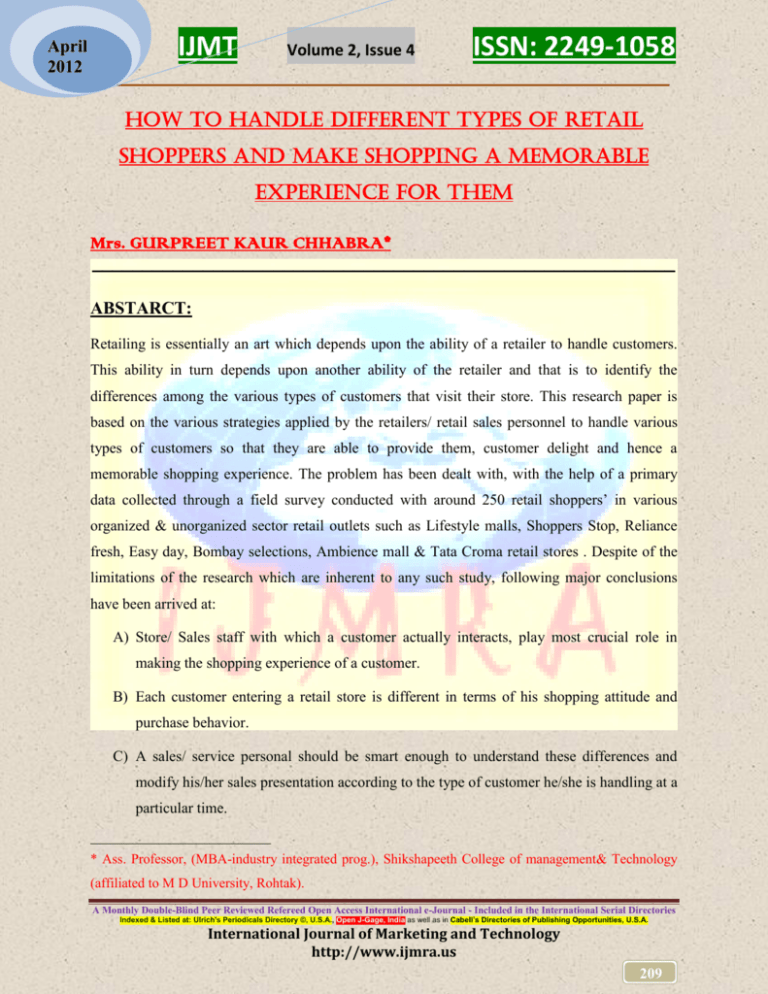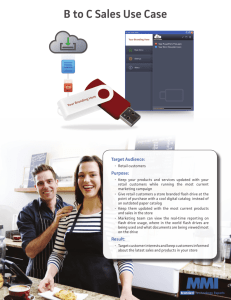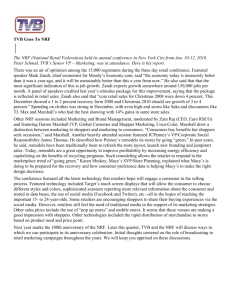HOW TO HANDLE DIFFERENT TYPES OF RETAIL SHOPPERS
advertisement

April 2012 IJMT Volume 2, Issue 4 ISSN: 2249-1058 __________________________________________________________ HOW TO HANDLE DIFFERENT TYPES OF RETAIL SHOPPERS AND MAKE SHOPPING A MEMORABLE EXPERIENCE FOR THEM Mrs. GURPREET KAUR CHHABRA* __________________________________________________________ ABSTARCT: Retailing is essentially an art which depends upon the ability of a retailer to handle customers. This ability in turn depends upon another ability of the retailer and that is to identify the differences among the various types of customers that visit their store. This research paper is based on the various strategies applied by the retailers/ retail sales personnel to handle various types of customers so that they are able to provide them, customer delight and hence a memorable shopping experience. The problem has been dealt with, with the help of a primary data collected through a field survey conducted with around 250 retail shoppers‟ in various organized & unorganized sector retail outlets such as Lifestyle malls, Shoppers Stop, Reliance fresh, Easy day, Bombay selections, Ambience mall & Tata Croma retail stores . Despite of the limitations of the research which are inherent to any such study, following major conclusions have been arrived at: A) Store/ Sales staff with which a customer actually interacts, play most crucial role in making the shopping experience of a customer. B) Each customer entering a retail store is different in terms of his shopping attitude and purchase behavior. C) A sales/ service personal should be smart enough to understand these differences and modify his/her sales presentation according to the type of customer he/she is handling at a particular time. * Ass. Professor, (MBA-industry integrated prog.), Shikshapeeth College of management& Technology (affiliated to M D University, Rohtak). A Monthly Double-Blind Peer Reviewed Refereed Open Access International e-Journal - Included in the International Serial Directories Indexed & Listed at: Ulrich's Periodicals Directory ©, U.S.A., Open J-Gage, India as well as in Cabell’s Directories of Publishing Opportunities, U.S.A. International Journal of Marketing and Technology http://www.ijmra.us 209 April 2012 IJMT Volume 2, Issue 4 ISSN: 2249-1058 __________________________________________________________ D) Profitability can be increased by handling different customers, differently. KEY WORD: Purchase process Retail shoppers Retail sales personal Retail shoppers‟ behavior Shopping attitudes Store image Shopping experience Did you ever realize that every time you experience the need for a particular product, the very next thought that comes to your mind is the place from where you want to purchase it? You often have preferences when it comes to choice of retail outlets. You may choose a particular outlet for buying wet grocery and the other one for buying dry grocery. You may prefer to buy western formals from Shoppers‟ stop, but when it comes to ethnic outfits you may prefer to visit a couple of retail outlets in the nearby local market. But have you ever wondered what pulls you towards that particular store? Or why you prefer to shop from that particular store only and at times don‟t even want to try any other store? Perhaps it is the brands available or it is the convenience, or it is the variety offered by the store or it is something else. Think again! Often it is the shopping experience or the way you are treated by the retailer that pulls you there again and again. The process through which shoppers make decisions related to the utilization of their time, money and efforts in order to procure, use and dispose off goods and services is known as Shopper‟s behavior. Although the process of purchase i.e. the stages through which a shopper passes, while he/she is taking purchase decision, is necessarily the same in all the cases however still the factors that influence the purchase decision vary from person to person. That is why A Monthly Double-Blind Peer Reviewed Refereed Open Access International e-Journal - Included in the International Serial Directories Indexed & Listed at: Ulrich's Periodicals Directory ©, U.S.A., Open J-Gage, India as well as in Cabell’s Directories of Publishing Opportunities, U.S.A. International Journal of Marketing and Technology http://www.ijmra.us 210 April 2012 IJMT Volume 2, Issue 4 ISSN: 2249-1058 __________________________________________________________ every shopper which is moving inside a retail store is not the same and thus should not be handled in the same way. According to a research, the most common reason for failure of many supposedly good retail stores, is their inability to understand differences among the customers and hence inability to handle them differently. They use the same sales presentation, same sales tactics and same strategies with each and every customer with whom they interact and therefore they are unable to convert each one of them. Although an ability to perceive consumer differences and using them to modify your sales talk will not ensure that you will be able to convince and convert each and every customer that moves into your store but it will help you attend them properly and cater to their needs in a much better manner so that even if they are not buying at the moment, yet they will carry a positive experience with them when they move out of the store, infact they will make an image of the store in their mind so that when ever they feel a particular need which they perceive can be best fulfilled at your store, they will automatically come to your store at times ,without even visiting any other store. Research indicates that in times to come, only those retailers who understand what their customers need and provide them with exactly what they want even before they ask for it, are the ones who are going to survive in this highly competitive sector of retail. The new FDI norms of government of India will not only help intensify the competition among local, national as well as international retailers but will also increase the need among the retailers to deeply understand the consumer differences so as to achieve the following: ~ By understanding the differences among different types of shoppers, a retailer will be able to target exactly the type of shoppers whom he/she feels that can be catered to, easily by him/her with the scope of its store and resource availability. ~ By specifying a target group, a retailer will be able to carve a niche for itself and hence avoid head on competition with big brands/retailers. This eventually will help him survive despite of an intense competition which the retail sector is likely to foresee in near future with the coming in of retail giants such as Wal-Mart, Carrefour etc. A Monthly Double-Blind Peer Reviewed Refereed Open Access International e-Journal - Included in the International Serial Directories Indexed & Listed at: Ulrich's Periodicals Directory ©, U.S.A., Open J-Gage, India as well as in Cabell’s Directories of Publishing Opportunities, U.S.A. International Journal of Marketing and Technology http://www.ijmra.us 211 April 2012 IJMT Volume 2, Issue 4 ISSN: 2249-1058 __________________________________________________________ ~ A customer always remembers a store where it got a special treatment. Especially if they had visited this store as a casual visitor. Research indicates the way store staff treats the causal visitors along with its regular customers determines the customer traffic of the store. Often these shoppers carry along their experiences with them even if they don‟t carry away their shopping bags out of the store and this is what brings them back as a customer and ultimately turns them into a loyal customer depending upon the way they were treated and understood by the retailer. ~ This not only helps you create new customers but also generate word-of –mouth advertisement and hence improve the image of the store, which on one hand decreases the expenditure on marketing and advertising (thereby reducing cost) and also generate more customers because now the fact is well established that a delighted customer is 5 times likely to discuss his/her experience with family and friends. ~ Another fact that has also come into light is that a dissatisfied customer is 10 times likely to discuss his /her bad experience with family/friends. Therefore it becomes more so important for the retailer to make shopping a memorable experience for majority of the shoppers visiting his/her store. In order to make shopping a memorable experience it is important that the retailer must analyze, understand & evaluate the differences that exist among the shoppers that visit his/her store and accordingly train the sales and service staff to handle the customer according to their types. To successfully implement this differential strategy it is important that the store staff is well trained in their ability to identify customer differences. Although there are various ways in which we can define a type of retail shopper, however the most common classification is based on the following aspects: On the basis of their shopping attitudes the retail customers can be classified as : A Monthly Double-Blind Peer Reviewed Refereed Open Access International e-Journal - Included in the International Serial Directories Indexed & Listed at: Ulrich's Periodicals Directory ©, U.S.A., Open J-Gage, India as well as in Cabell’s Directories of Publishing Opportunities, U.S.A. International Journal of Marketing and Technology http://www.ijmra.us 212 April 2012 IJMT Volume 2, Issue 4 ISSN: 2249-1058 __________________________________________________________ 1) DEFENSIVE SHOPPER- such types of shoppers distrust the retail sales person and feel that he/she has the only objective of pushing the product across the retail counter and therefore usually are skeptical about the products suggested to them by the sales personnel. STRATEGY TO HANDLE SUCH TYPE OF CUSTOMERS: These types of customers can be easily identified by the way they react to the assistance offered to them. Such types of customers prefer to be left alone and take their own purchase decision. Sales persons should be advised not to talk much to such customers, offer advice only when asked for. 2) INTERRUPTIVE SHOPPER- such type of shoppers are very impatient, they won‟t listen to your sales talk and are always eager to show how off ,their knowledge about the products to the sales person. They would often interrupt you in your sales presentation, saying that they already know a lot about what they want and at times would get involved in detailing the product themselves to the sales person thereby showing him/her their wide knowledge base. STRATEGY TO HANDLE SUCH TYPE OF CUSTOMERS: Acknowledge and appreciate their wisdom and knowledge. Don‟t be cross with them. Such types of shoppers are easily impressed if a sales person is humble and patient to listen to their knowledgeable views. Therefore instead of you doing the talking, let them speak and as soon as you get a cue that they are aware about the product/brand and are impressed with it, close the sales call with a sweet smile and say, “what else can I say, sir you already know everything so well. So how much should I pack.” 3) DECISIVE CUSTOMER- although these customers are quiet knowledgeable but they won‟t show off the same to the sales person, instead they would patiently listen to the sales talk and raise valid questions and queries to the sales person. They are open to new A Monthly Double-Blind Peer Reviewed Refereed Open Access International e-Journal - Included in the International Serial Directories Indexed & Listed at: Ulrich's Periodicals Directory ©, U.S.A., Open J-Gage, India as well as in Cabell’s Directories of Publishing Opportunities, U.S.A. International Journal of Marketing and Technology http://www.ijmra.us 213 April 2012 IJMT Volume 2, Issue 4 ISSN: 2249-1058 __________________________________________________________ ideas and suggestions. These shoppers if convinced can be converted to a customer very easily and that too a loyal one. STRATEGY TO HANDLE SUCH CUSTOMERS: The biggest mistake that a sales person can do is to argue with these types of customers and offend them. They are very sure of their decisions and although are ready to experiment with new ideas or suggestions but after a lot of thinking. They take time in taking decisions but once they are convinced they stick to their decisions. Sales personals are advised to spend quality time with these shoppers and don‟t show a pushy attitude to such customers. Let them take decision at their own pace. 4) INDECISIVE CUSTOMER- these types of customers are undecided about what they actually want they can be highly profitable if handled properly. They can be very easily converted to a loyal customer also if the store sales/service staff treats them well and most importantly help them arrive at a purchase decision. STRATEGY TO HANDLE SUCH CUSTOMERS: The major advantage such customers offer to a sales person is „their inability to decide‟, a sales person can get a cue of such customer from the way they roam around the store with a weary or amazed look. They would pick up something and then drop it to take up something new. At times they may ask for assistance or they might not do so and would leave the store with out actually looking at something, therefore the main role that a sales person is suppose to play is to help them in not only showing around, what the store has on sale but to also assist them in taking final purchase decision. The help should be offered in such a way that the customer should not feel that you have taken decision for him/her. Hence don‟t leap at the chance to do cross/up selling unless you feel that the customer will be ready for it or won‟t mind additional dip on his/her pocket. Let him/her come back next time and perhaps you can get more sales done or more incentives achieved rather than making the kill in one go. A Monthly Double-Blind Peer Reviewed Refereed Open Access International e-Journal - Included in the International Serial Directories Indexed & Listed at: Ulrich's Periodicals Directory ©, U.S.A., Open J-Gage, India as well as in Cabell’s Directories of Publishing Opportunities, U.S.A. International Journal of Marketing and Technology http://www.ijmra.us 214 April 2012 IJMT Volume 2, Issue 4 ISSN: 2249-1058 __________________________________________________________ 5) SOCIABLE CUSTOMER- such type of customers are the ones whom every sales person wants to avoid as they eat away a lot of peak time and yet it is not clear whether they are going to buy or not. They cannot be ignored as they often visit the store again and again and therefore eventually become store loyal. They can be a source of „word-ofmouth‟ publicity too. STATEGY TO HANDLE SUCH CUSTOMERS: The major mistake a store can commit as far as such customers are concerned is to take them as casual wanderers. They can be easily identified from their overfriendly behavior and their interest in gossiping around with the store staff. It is desirable to enter into a small talk with them along with showing them around the store items. The major problem with such customers is that they take a lot of time in arriving at a decision. 6) IMPULSIVE CUSTOMERS- The most unpredictable customers. They shift their decisions very swiftly. They take quick purchase decision at a moment and the very next moment they may change their decision and drop the idea of buying anything from the store. Occasionally do these customers turn out to be loyal customers however at times they can turn out to be profitable ones due to their impulsive behavior. STRATEGY TO HANDLE SUCH CUSTOMERS: These customers can be easily identified from their inability to stick to one decision or quick decision making or their impulsive behavior. Although they hardly return back to the same store again, still can be profitable one time catch for a sales person as they take fast decisions and hence save his precious time. But it is only possible if the sales person is smart enough to understand their psyche and body language and as soon as they tend to arrive towards the final purchase decision he/she should try to close the sales immediately. Pushy sales strategy works well with these types of shoppers. A Monthly Double-Blind Peer Reviewed Refereed Open Access International e-Journal - Included in the International Serial Directories Indexed & Listed at: Ulrich's Periodicals Directory ©, U.S.A., Open J-Gage, India as well as in Cabell’s Directories of Publishing Opportunities, U.S.A. International Journal of Marketing and Technology http://www.ijmra.us 215 April 2012 IJMT Volume 2, Issue 4 ISSN: 2249-1058 __________________________________________________________ Retailers often focus on creating new customers with the help of its advertising, publicity and sales promotion activities. The strategies mentioned above can help the retailer identify, handle and categorize new customers but a retailer should not loose focus of those 20% frequent customers who usually generate majority of a retailers sales.(Pareto rule). The existing customers can be classified into the following two categories: a) LOYAL CUSTOMERS- approximately 50% of a store‟s sale comes from these regular, loyal and dedicated customers. They are hooked to a particular store and don‟t need to be reminded again and again about the store. STRATEGY TO HANDLE SUCH CUSTOMERS: Regular follow ups through mail, telephone or SMS is a must. Whenever the new stock arrives they should be the first ones to be informed. Offer special discounts, offers and schemes specifically designed for these shoppers. Although whatever best you do for them, is not enough. Yet the more services you offer them, the more privileged they feel, the more they will recommend your store to others. b) DISCOUNT CUSTOMERS- their visit frequency depends upon the type and amount of the discounts offered by the store. The only thing that attracts them to a store is the offers and discounts offered by the retailer. They are the cash generators. STRATEGY TO HANDLE SUCH CUSTOMERS: Since they are only attracted towards the marked down price tags therefore limit the services offered to them. However keep them updated about your end season sales or discount offers, on regular basis. Just like management, retailing is also an art as well as science. While the scientific back support comes from the way a store is administered and its financial soundness whereas the art of retailing depends upon the efficacy, efficiency and effectiveness of the store staff in handling customers and making shopping a memorable experience for them. So A Monthly Double-Blind Peer Reviewed Refereed Open Access International e-Journal - Included in the International Serial Directories Indexed & Listed at: Ulrich's Periodicals Directory ©, U.S.A., Open J-Gage, India as well as in Cabell’s Directories of Publishing Opportunities, U.S.A. International Journal of Marketing and Technology http://www.ijmra.us 216 April 2012 IJMT Volume 2, Issue 4 ISSN: 2249-1058 __________________________________________________________ that they come over again and again to the store not only for shopping but to relish that wonderful shopping experience and share the same with others. REFERENCES: Retail Management by Dr. Harjit Singh, excel publishers Retail Sales Techniques by Dr. Harjit Singh, Vikas publishing house Image for better footfall by Gurpreet Kaur Chhabra, Business & management (Chronicle publications, New Delhi) MAY 2011 issue What makes shoppers buy and decide from where to buy- a guide to successful retailing, by Gurpreet Kaur Chhabra MERI journal of mgmt. & technology(PEER reviewedl, ISSN-0974-2093, Listed in Cabell’s Directory, USA) APRIL 2011 issue, volume 4, Number 2 Five types of retail shoppers- by Mark Hunter (source www.ThesalesHunter.com) A Monthly Double-Blind Peer Reviewed Refereed Open Access International e-Journal - Included in the International Serial Directories Indexed & Listed at: Ulrich's Periodicals Directory ©, U.S.A., Open J-Gage, India as well as in Cabell’s Directories of Publishing Opportunities, U.S.A. International Journal of Marketing and Technology http://www.ijmra.us 217







